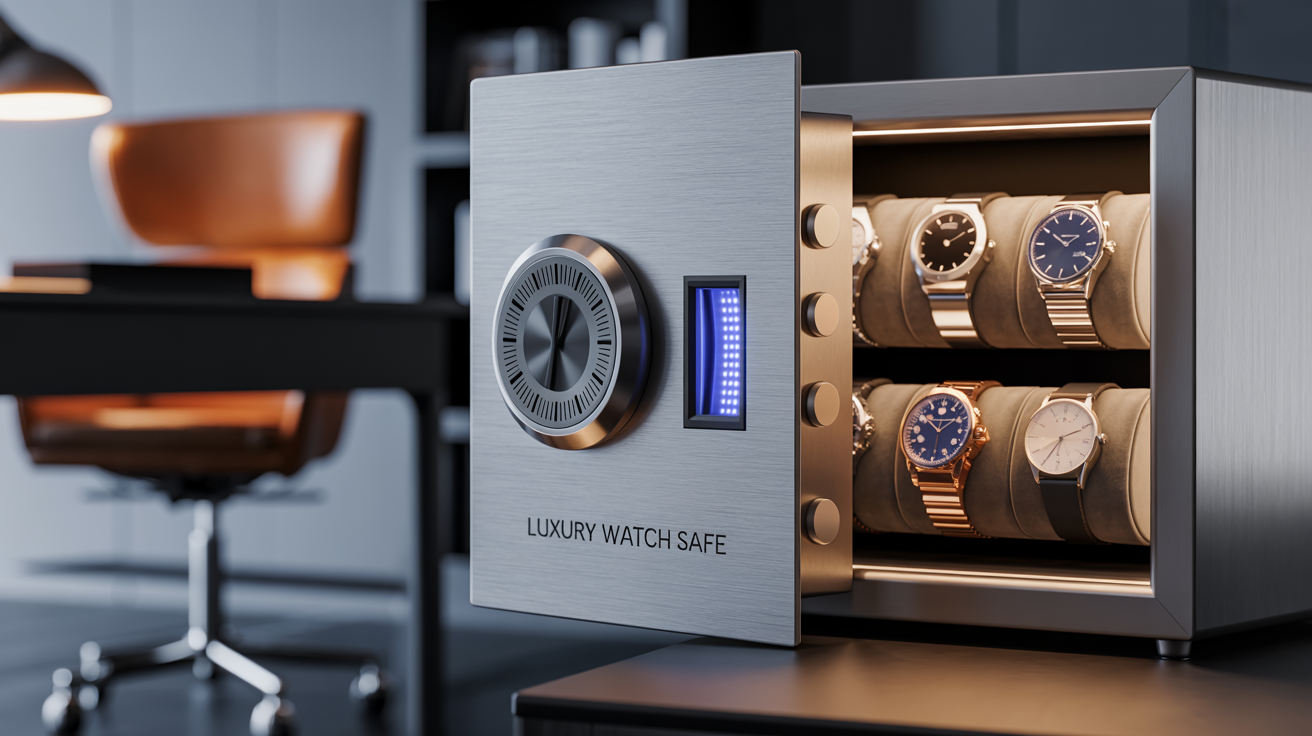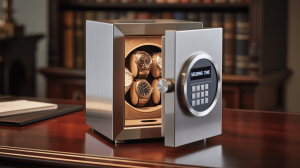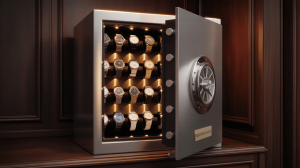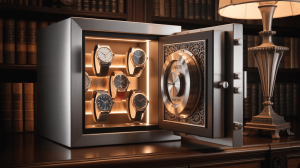Luxury Watch Safe Tech: Biometric Locks & Concealed Designs
In the world of high‑end timepiece storage, professionals face the challenge of protecting valuable watches from theft and environmental damage. This article explains how advanced biometric locking systems and stealth design elevate security while maintaining elegance. What’s the real story? By examining the core features, customization options, and industry standards, readers gain the insights they need to select the ideal solution for their B2B clients. Trust our expertise as we guide you through every critical decision point.
1. What is luxury watch safe tech?
Luxury watch safe tech refers to specialized vaults designed exclusively for storing premium mechanical and automatic watches. These safes combine precision‑engineered locking mechanisms with materials that resist both forced entry and environmental threats like humidity or dust. Built for retailers, hotels, and private collectors, each unit ensures that every watch remains in pristine condition, even when left unworn for extended periods. But here’s the key… these safes aren’t simply heavy boxes; they integrate intelligent features that cater to the specific needs of watch care and asset protection.
Unlike conventional security safes, a luxury watch safe incorporates modular interiors—customizable watch cradles or winders that keep automatic movements running within factory tolerances. Many also offer discreet installation methods, such as in‑wall or under‑furniture mounting, so the safe blends seamlessly into its environment. Standard safes focus on general valuables; luxury watch safes center on preserving mechanical accuracy and display aesthetics. That distinction matters for B2B buyers who must satisfy discerning end users.
Professionals and institutions gain three critical benefits: enhanced security, preservation of watch performance, and discretion. Biometric or digital locks reduce risk of unauthorized access. Interior silencing and padded cradles prevent scratches during rotations. Concealed designs maintain room aesthetics in showrooms or executive offices. Are you ready for the exciting part? These safes support multi‑unit configurations, allowing businesses to scale storage without compromising on quality or brand consistency. Retailers can offer white‑label solutions, while bespoke furniture makers integrate safes into custom cabinetry.
| Concealment Type | Installation Location | Estimated Cost Range |
|---|---|---|
| In‑wall flush mount | Behind drywall, furniture | $3,500–$6,000 |
| Under‑desk drawer | Officer desks, reception | $2,800–$4,500 |
| Panel‑door integration | Custom cabinetry, gallery walls | $4,200–$7,000 |
| Rotating bookshelf | Private offices, libraries | $5,000–$8,500 |
2. How do biometric locks function?
Biometric locks rely on unique biological markers—fingerprint, iris recognition or even palm‑vein scanning—to grant access. During setup, an administrator enrolls authorized users’ biometrics into the safe’s secure memory. On each entry attempt, the scanner captures and matches live data against stored templates using encryption algorithms. But here’s the key… false‑acceptance and false‑reject rates are calibrated below 0.001%, ensuring both convenience and high security.
Data captured by biometric sensors is encrypted with AES‑256 or higher, preventing interception. Should power fail, many systems activate a mechanical override requiring a hardened key or code. That redundancy ensures access for legitimate users while maintaining resistance to tampering. Firmware updates keep algorithms current against emerging spoofing techniques.
Manufacturers publish biometric performance in terms of False Reject Rate (FRR) and False Accept Rate (FAR). A top‑tier luxury watch safe aims for FRR <0.01% and FAR <0.001%. Regular calibration and sensor cleaning are recommended to sustain these metrics. The exciting part is now… these safes can log every access event, creating audit trails that integrate with corporate security systems for compliance and loss prevention.
| Feature | Typical Specification | Benefit |
|---|---|---|
| FRR | <0.01% | Low user frustration |
| FAR | <0.001% | High security confidence |
| Encryption Standard | AES‑256 | Protection of stored biometrics |
| Power Backup | 12 hrs battery | Uninterrupted access during outages |
3. Why choose a concealed safe design?
Concealed watch safes vanish within walls, under desks, or behind art panels. Cabinet‑makers match veneers and finishes precisely, rendering safes invisible to the untrained eye. What’s the real story? Discretion reduces temptation among visitors or staff.
Criminals often scout visible safes. Hiding the unit removes any direct target. With door thickness and anchoring equal to freestanding models, concealed safes deliver identical resistance ratings without advertising their location.
From exotic wood veneers to leather‑wrapped exteriors, finish choices let clients align safes with luxury decor. Panels can be replaced for rebranding or seasonal displays. Are you ready for the exciting part? These design freedoms help retailers and hoteliers maintain brand consistency while offering top‑tier security.
| Concealment Style | Visibility Level | Ideal Use Case |
|---|---|---|
| Behind drywall | None | Executive offices |
| Under‑desk drawer | Minimal | Reception areas |
| Custom cabinetry panel | Invisible | Luxury showrooms |
| Rotating bookshelf | Hidden | Private study rooms |
4. What materials and build quality matter?
High‑security safes use steel alloys with tensile strength >500 MPa and composite fire linings rated for at least 1 hour at 1700 °F. Thicker doors (up to 4″) improve both burglary and fire resistance. But here’s the key… investing in premium materials upfront reduces long‑term maintenance and insurance costs.
Premium fabrics prevent scratching; watch modules cradle timepieces during rotations. Replaceable cushions extend safe life without full interior refits. Look for UL TL‑15/TL‑30 burglary and UL 350 fire certifications. CE EN 1143‑1 ratings signal European compliance; ISO 9001 factories ensure consistent production quality.
| Component | Specification | Purpose |
|---|---|---|
| Steel Grade | >500 MPa tensile strength | Physical breach resistance |
| Fire Lining | 1 hr at 1700 °F | High‑temperature insulation |
| Interior Fabric | Microfiber or velvet | Scratch prevention |
| Cushion Modules | Foam‑inserted watch cradles | Secure watch positioning |
5. How does customization work?
Laser or CNC engraving embeds brand or hotel logos on door or interior panels. Silk‑screen printing adds color accents. But here’s the key… customization fosters brand loyalty among end users.
Swap modules to store between 1 and 12 watches per unit. Extra compartments for jewelry or documents are optional. Clients can choose matte, gloss, woodgrain or leather‑wrapped finishes to match decor. Are you ready for the exciting part? Modular interiors snap into place without tools, enabling on‑demand reconfiguration for seasonal or promotional needs.
| Custom Option | Details | Benefit |
|---|---|---|
| Logo Engraving | Laser or CNC | Brand reinforcement |
| Module Count | 1–12 watch slots | Scalability |
| Finish Choices | Matte, gloss, woodgrain, leather | Aesthetic alignment |
| Additional Compartments | Jewelry, documents | Versatility |
6. Which security certifications count?
TL‑15 resists 15 minutes of tool‑based attack; TL‑30 extends defense to 30 minutes. UL 350 fire protection covers 1 hour at high temperatures. EN 1143‑1 Grades I–VI escalate burglary resistance; Grade II suits mid‑tier needs, Grades V–VI handle extreme risk. Insurance mandates often specify certification levels. But here’s the key… higher ratings correlate with lower premiums and greater client trust.
| Certification | Resistance Rating | Insurance Impact |
|---|---|---|
| UL TL‑15 | 15 min tool attack | Standard premium |
| UL TL‑30 | 30 min extended defense | Reduced premium |
| UL 350 | 1 hr fire protection | Document compliant |
| EN Grade II | Moderate tool resistance | Common commercial use |
| EN Grade V | High security | High‑value collections |
7. How can you integrate smart features?
Safes with GSM or Wi‑Fi modules push open/close notifications directly to smartphones. App‑based dashboards provide audit trails showing which credential accessed the unit and when. Rechargeable batteries maintain functionality up to 12 hours during outages. Are you ready for the exciting part? These integrations tie into corporate security platforms, enabling unified monitoring across multiple locations.
8. How do you pick the right capacity?
Decide based on current inventory and growth projections; modules snap into place without tools. Measure available depth and height; shallow safes suit under‑desk mounts, deeper units need in‑wall recesses. For scaling, choose models that stack side by side or vertically for easy future expansion. What’s the real story? Planning capacity at purchase prevents costly retrofits as collections expand.
9. What does installation involve?
Certified technicians ensure code‑compliant anchoring; DIY options exist for simpler models. Wall‑inset methods vary between concrete and stud‑wall anchors. High‑traffic areas deter burglars; hidden closets or behind‑art installations work well in showrooms and suites. But here’s the key… professional installation preserves warranty and safety ratings.
| Installation Type | Prep Required | Duration |
|---|---|---|
| In‑wall flush mount | Drywall cut‑out, wiring | 4 hrs |
| Under‑desk mount | Desk modification | 2 hrs |
| Free‑standing bolt‑down | Floor drilling | 1.5 hrs |
| Custom cabinetry | Cabinet build‑out | 6 hrs |
| Rotating bookshelf | Hinge and mechanism fit | 5 hrs |
10. What maintenance steps are required?
Schedule quarterly tests of biometric readers or keypads. Every six months, vacuum interiors and swap worn cushions. Apply firmware updates as released by manufacturers. The exciting part is now… proactive maintenance extends safe lifespan and keeps security measures at peak performance.
11. How should you compare pricing?
Compare core safe price against modules, finishes and electronics. Factories often offer 5–15% discounts on 10+ unit orders. Calculate total cost of ownership across warranty and expected maintenance periods to evaluate long‑term value. Are you ready for the exciting part? Volume buys and bundled service plans can reduce overall expenditure significantly.
12. Who are the top suppliers?
Leading names include Homisafe, Buben & Zörweg, Barrington, Casoro and Orient Crown. Direct factory purchases minimize markup; private‑label deals allow branding control. Verify ISO 9001 status and request client references to ensure supplier reliability. What’s the real story? Partnering with established manufacturers reduces risks in quality and delivery.
| Supplier | HQ | Strength |
|---|---|---|
| Homisafe | Foshan, China | Large‑scale custom production |
| Buben & Zörweg | Germany | Luxury heritage craftsmanship |
| Barrington | UK | Modular innovation |
| Casoro | USA | Bespoke design |
| Orient Crown | Singapore | Regional customization |
13. How do warranties and service work?
Standard coverage runs one year on electronics and three years on mechanical parts. Extended plans cover up to five years; on‑site support incurs travel fees. OEM parts ship within 48 hours; aftermarket options vary by region. But here’s the key… clear service terms prevent unexpected downtime.
14. What are the latest market trends?
Clients favor invisible safes that double as wall art. Solar‑assist battery chargers and recycled composites reflect sustainability priorities. Integration with hotel PMS or corporate security platforms streamlines operations. Are you ready for the exciting part? Early adopters gain marketing edge by promoting eco‑credentials and smart building compatibility.
15. How do you market to B2B customers?
Target retailers, hospitality groups and galleries handling luxury merchandise. Emphasize risk reduction, brand alignment and total cost efficiency in pitch decks. Offer tiered pricing, on‑site demos and ROI case studies to nurture leads. But here’s the key… tailored proposals outperform generic brochures by addressing each client’s unique pain points.
Question 1: What is luxury watch safe tech?
Luxury watch safe tech means specialized vaults engineered for premium watch storage, combining high‑end locking mechanisms and concealed designs.
Question 2: How do biometric locks work?
They scan unique biological traits—fingerprint or iris—and match encrypted templates before granting access.
Question 3: Why opt for concealed designs?
Stealth placement removes visible targets and integrates safes into custom interiors for added discretion.
Question 4: What certifications should I look for?
Seek UL TL‑15/TL‑30 and EN 1143‑1 ratings, along with UL 350 fire protection.
Question 5: How do I choose the right capacity?
Assess current collection size, forecast growth and verify installation space before selecting single or multi‑watch modules.







